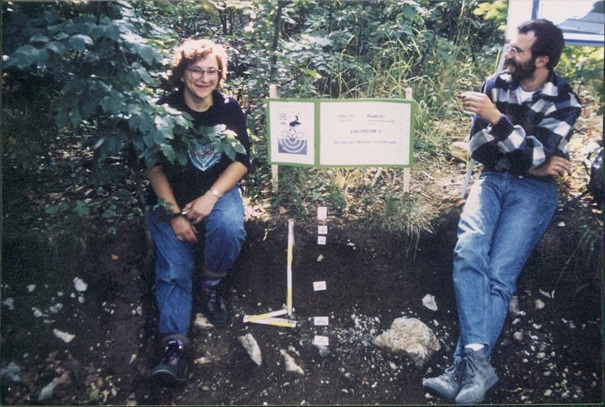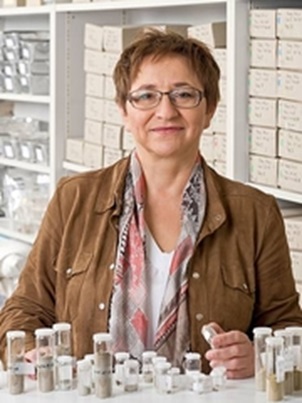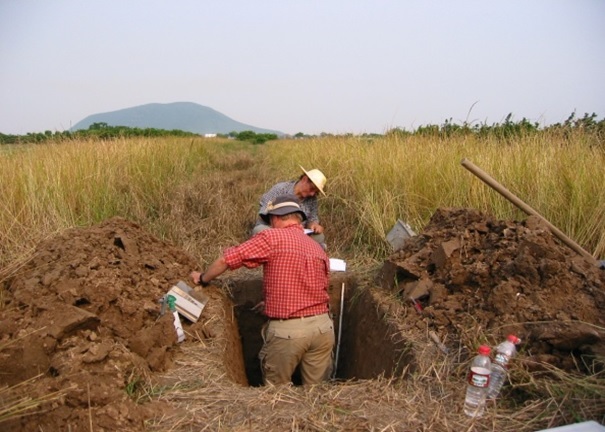Ingrid Kögel-Knabner
Chair of Soil Science
Technical University of Munich
The 2015 Philippe Duchaufour Medal is awarded to Ingrid Kögel-Knabner for her fundamental and ground-breaking work on the dynamics and stabilisation of soil organic matter in soils from a basic-chemistry and organo-mineral interactions perspective.
I received my doctorate from the University of Bayreuth, Germany, in 1987. In 1992 I became a professor of soil science and soil ecology at the Ruhr-Univeristät Bochum.I joined the Life Sciences Center of Technische Universität München (TUM) in 1995 as Professor in Soil Science. Since 2011 I am also a Carl von Linde Senior Fellow at the TUM Institute for Advanced Study.
I first was intrigued by soils at the age of 18, when I had to choose a topic for a term paper. I choose to write about the restoration of soils after open cast brown coal mining in Germany, and got the best mark possible. When I had to decide later in my geoecology studies between a major in soil science or hydrology, I was sure that soil science was my choice. I liked soil science because one can view, smell and touch soils, and I also liked the colours of soils. It is fascinating to work with such a complex organo-mineral material. In soil science you can work with organic or mineral materials, or microbes or animals, and it remains a challenge to understand the complete system. I have never regretted this choice.
I had several inspiring teachers. Wolfgang Zech (now retired) was an excellent teacher for soil science in general and even more so in the field. He was able to stimulate a desire to work with soils in each of his lectures. From Pat Hatcher (now at Old Dominion University) I learned to use 13C NMR spectroscopy to investigate soil organic matter . He invited me to his lab (at this time one of the two labs world-wide doing 13C NMR spectroscopy of soil organic matter), inspired and teached me to work with this (at that time) emerging technique. Konrad Haider and J. Malcolm Oades (both retired) were my guides as a postdoc when I started to work on more diversified fields of soil organic matter research. When arriving at Weihenstephan I had the chance for close interaction with Udo Schwertmann and learned more about soul minerals and specifically iron oxides. Thus I felt confident to work on organic and mineral materials and their interactions in soils.
My earlier work started with the structural analysis of soil organic matter in classical humic fractions. With the use of solid-state 13C NMR spectroscopy in combination with chemolytic techniques it was possible to leave the conceptional dead end, in which soil science had been led by traditional structural analyses of soil organic matter. It was now evident that aromatic carbon and lignin had been overestimated in the formation of soil organic matter and the importance of aliphatic compounds and polysaccharides was elucidated. While it was generally considered that clay minerals are the major agents in the formation of stable organo-mineral associations in soils, our work has revealed that the stabilisation of soil organic matter in temperate soils is specific with respect to the type of organic matter stabilized, i.e. polysaccharides and proteins, and is mediated via phyllosilicate clay minerals and nano-particulate iron oxides. As we increasingly understand how to obtain meaningful physical fractions of soils we try to acquire specific information on soil organic matter structure and linked this with essential functional aspects of these soil organic matter fractions.

Preparing a soil profile for the meeting of the German Soil Science Society 1991 in Bayreuth together with Kai U. Totsche.
The soil processes of stabilization of organic matter i.e. the formation of organo-mineral associations and the concurrent occlusion of organic particles in aggregated soil structures occur at the sub-micron scale. To unravel the formation of SOM in occluded aggregates as well as organo-mineral associations, an in-situ analysis of soil particles is necessary to gain precise information on their association and properties. To investigate the evolution and composition of submicron sized organo-mineral associations and aggregate interiors, novel micro-analytical techniques are used that allow the simultaneous analysis of the spatial distribution of elements involved in stabilization processes (e.g. C, N, Si, Al and Fe). Soil management, especially the type and intensity of land use, affect the carbon cycle to a high extent as they modify carbon sequestration in a specific soil. Thus man is intervening in the natural carbon cycle on a global scale. Understanding the binding of organic matter in the fine soil structures then provides a means to evaluate the effects of soil management on organic matter binding. Examples for such management-induced controls on carbon sequestration are tillage in cropland soils, grazing management in steppe soils, and paddy soil management for rice production.
Selected publications
- Bimüller C, Mueller CW, Von Lützow M, Kreyling O, Kölbl A, Haug S, Schloter M, Kögel-Knabner I (2014) Decoupled carbon and nitrogen mineralization in soil particle size fractions of a forest topsoil. Soil Biology & Biochemistry 78, 263-273. DOI: 10.1016/j.soilbio.2014.08.001.
- Eusterhues K, Rumpel C, Kögel-Knabner I (2005) Organo-mineral associations in sandy acid forest soils: importance of specific surface area, iron oxides and micropores. European Journal of Soil Science 56, 753-763. DOI: 10.1111/j.1365-2389.2005.00710.x.
- Kiem R, Kögel-Knabner I (2003) Contribution of lignin and polysaccharides to the refractory carbon pool as studied in C-depleted arable soils. Soil Biology & Biochemistry 35, 101-118. DOI: 10.1016/S0038-0717(02)00242-0.
- Kögel-Knabner I, Guggenberger G, Kleber M, Kandeler E, Kalbitz K, Scheu S, Eusterhues K, Leinweber P (2008) Organo-mineral associations in temperate soils: integrating biology, mineralogy and organic matter chemistry. Journal of Plant Nutrition and Soil Science 171, 61-82. DOI: 10.1002/jpln.200700048.
- Rumpel C, Kögel-Knabner I, Bruhn F (2002) Vertical distribution, age, and chemical composition of organic carbon in two forest soils of different pedogenesis. Organic Geochemistry 33, 1131-1142. DOI: 10.1016/S0146-6380(02)00088-8.
- Vogel C, Mueller CW, Höschen C, Buegger F, Heister K, Schulz S, Schloter M, Kögel-Knabner I (2014) Submicron structures provide preferential spots for carbon and nitrogen sequestration in soils. Nature Communications, 5:2947. DOI: 10.1038/ncomms3947.
- Wiesmeier M, Spörlein P, Geuß U, Hangen E, Haug S, Reischl A, Schilling B, von Lützow M, Kögel-Knabner I (2012) Soil organic carbon stocks in southeast Germany (Bavaria) as affected by land use, soil type and sampling depth. Global Change Biology 18, 2233-2245. DOI: 10.1111/j.1365-2486.2012.02699.x.
- Wissing L, Kölbl A, Vogelsang V, Fu JR, Cao ZH, Kögel-Knabner I (2011) Organic carbon accumulation in a 2000-year chronosequence of paddy soil evolution. Catena 87, 376-385. DOI: 10.1016/j.catena.2011.07.007.
This post has been simultaneously published in G-Soil.



Pingback: Ingrid Kögel-Knabner, a multidisciplinary soil scientist | G-Soil